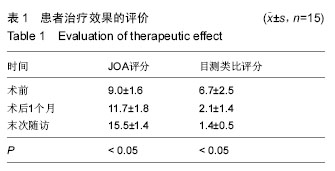| [1] 刘忠军.颈椎后纵韧带骨化症的手术入路选择策略之我见[J].中国脊柱脊髓杂志,2010,20(3):180-181.
[2] Lee CK, Shin DA, Yi S, et al. Correlation between cervical spine sagittal alignment and clinical outcome after cervical laminoplasty for ossification of the posterior longitudinal ligament. J Neurosurg Spine. 2016;24(1): 100-107.
[3] 陈德玉,卢旭华,陈宇,等.颈椎病合并颈椎后纵韧带骨化症的前路手术治疗[J].中华外科杂志,2009,4(47): 610-612.
[4] 田伟,韩骁,刘渡,等. 应用矢状位重建CT进行颈椎后纵韧带骨化手术方式的选择[J].中华外科杂志,2012, 50(7): 590-595.
[5] Fujiyoshi T, Yamazaki M, Kawabe J, et al. A new concept for making decisions regarding the surgical approach for cervical ossification of the posterior longitudinal ligament: the K-line. Spine (Phila Pa 1976). 2008;33(26): E990-993.
[6] 贾斌,栾冠楠,陈宇飞,等.K线在预测颈椎全椎板切除减压治疗多节段后纵韧带骨化症疗效中的应用[J].中国矫形外科杂志,2015,23(11):981-985.
[7] Hirabayashi K, Miyakawa J, Satomi K, et al. Operative results and postoperative progression of ossification among patients with ossification of cervical posterior longitudinal ligament. Spine. 1981; 6(4):354-364.
[8] Epstein NE. Identification of ossification of the posterior longitudinal ligament extending through the dura on preoperative computed tomographic examinations of the cervical spine. Spine. 2001;26(2): 182-186.
[9] Lee M, Wu BM. Recent advances in 3D printing of tissue engineering scaffolds. Methods Mol Biol. 2012; 868: 257-267.
[10] Mavili ME, Canter HI, Saglam-Aydinatay B, et al. Use of three-dimensional medical modeling methods for precise planning of orthognathic surgery. J Craniofac Surg. 2007;18(4): 740-747.
[11] 张元智,裴国献,陆声,等. 计算机辅助确定下肢机械轴线在全膝关节置换术中的应用[J]. 中华骨科杂志,2013, 33(12):1196-1203.
[12] 甘煜东,徐达传,陆声,等. 数字化导航模板辅助全膝关节置换的模拟研究[J]. 中华骨科杂志,2011,31(9): 964-969.
[13] 邱冰,张明娇,唐本森,等.个性化手术导板在全膝关节置换术中的应用[J].中华骨科杂志,2016,36(3):143-150.
[14] 左睿,孙永建,吴毅,等.3D打印与虚拟手术设计在复杂胫骨平台骨折手术治疗中的应用[J].中国骨与关节损伤杂志,2016,31(4):369-372.
[15] 李涛,陈卓夫,龚辉,等.3D打印技术在复杂髋臼骨折术中的初步临床应用[J].中国骨与关节损伤杂志,2016,31(4): 387-388.
[16] 庞骄阳,赵岩,肖宇龙,等.3D打印技术在脊柱外科的应用[J].中国组织工程研究,2016,20(4):577-582.
[17] 吴爱悯,金海明,车灿文,等.上颈椎3D打印模型的精确性验证及在前路枕-寰-枢螺钉内固定术中的可行性[J].中华创伤杂志,2016,32(1):41-46.
[18] Ferrari V, Parchi P, Condino S, et al. An optimal design for patient-specific templates for pedicle spine screws placement. Int J Med Robot. 2013;9(3):298-304.
[19] Kaneyama S, Sugawara T, Sumi M, et al. A novel screw guiding method with a screw guide template system for posterior C•-2 fixation:clinical article. J Neurosurg Spine. 2014;21(2):231-238.
[20] Yang JC,Ma XY,Xia H,et al.Clinical application of computer-aided design-rapid prototyping in C 1--C2 operation techniques for complex atlantoaxial instability. J Spinal Disord Tech. 2014;27(4): E143-150.
[21] Merc M,Drstvensek I,Vogrin M,et al.Error rate of multi-level rapid prototyping trajeetories for pedicle screw placement in lumbar and sacral spine.Chin J Traumatol. 2014;17(5):261-266.
[22] Hu Y,Yuan ZS,Kepler CK,et a1.Deviation analysis of C1-C2 transarticular screw placement assisted by a novel rapid prototyping drill template:a cadaveric study.J Spinal Disord Tech. 2014;27(5):E181-186.
[23] 姜良海,谭明生,董亮,等.3D打印导板在脊柱置钉中的应用研究进展[J].中国矫形外科杂志,2015,23(10):908-911.
[24] Wu AM, Shao ZX, Wang JS, et al. The accuracy of a method for printing three-dimensional spinal models. PloS one. 2015; 10(4): 1-11.
[25] Bredow J, Oppermann J, Kraus B, et al. The accuracy of 3D fluoroscopy-navigated screw insertion in the upper and subaxial cervical spine. Eur Spine J. 2015; 24(12): 2967-2976.
[26] Lu S, Xu YQ, Zhang YZ, et al. Rapid prototyping drill guide template for lumbar pedicle screw placement. Chin J Traumatol. 2009;12(3): 177-180.
[27] Sugawara T, Higashiyama N, Kaneyama S, et al. Multistep pedicle screw insertion procedure with patient-specific lamina fit-and-lock templates for the thoracic spine: clinical article. J Neurosurg Spine. 2013;19(2): 185-190.
[28] Xu N, Wei F, Liu X, et al. Reconstruction of the Upper Cervical Spine Using a Personalized 3D-Printed Vertebral Body in an Adolescent With Ewing Sarcoma. Spine. 2016;41(1): E50-54.
[29] Wu C, Tan L, Lin X, et al. Clinical application of individualized reference model of sagittal curves by three-dimensional printing technique and computer-aided navigation system for lumbar spondylolisthesis. Zhongguo Xiu Fu Chong Jian Wai Ke Za Zhi 2015;29(6):734-740.
[30] 陈宣煌,许卫红,黄文华,等.基于3D打印的腰椎椎弓根螺钉数字化置入及临床应用[J].中国组织工程研究,2015, 19(17):2752-2757.
[31] Joseph V, Kumar GS, Rajshekhar V. Cerebrospinal fluid leak during cervical corpectomy for ossified posterior longitudinal ligament: incidence, management, and outcome. Spine (Phila Pa 1976). 2009;34(5): 491-494.
[32] Fengbin Y, Xinyuan L, Xiaowei L, et al. Management and Outcomes of Cerebrospinal Fluid Leak Associated With Anterior Decompression for Cervical Ossification of the Posterior Longitudinal Ligament With or Without Dural Ossification. J Spinal Disord Tech. 2015;28(10): 389-393.
[33] Hirabayashi K, Miyakawa J, satomi K, et al. Operative results and postoperative progression of ossification among patients with ossification of cervical posterior longitudinal ligament. Spine. 1981;6(4): 354-364.
[34] 陈欣,庄颖峰,孙宇,等.单开门颈椎管扩大椎板成形术治疗颈椎后纵韧带骨化症的中远期疗效观察[J].中国脊柱脊髓杂志,2015,25(12):1057-1062.
[35] Jang JS, Lee SH, Min JH, et al. Surgical treatment of failed back surgery syndrome due to sagittal imbalance. Spine. 2007;32(26):3081-3087.
[36] Yeh KT, Yu TC, Chen IH, et al. Expansive open-door laminoplasty secured with titanium miniplates is a good surgical method for multiple-level cervical stenosis. J Orthop Surg Res. 2014;9: 49.
[37] 陈刚,戴腾,施克勤,等.后路单开门椎管成形术与全椎板切除减压术治疗颈椎后纵韧带骨化症的对比研究[J].中国矫形外科杂志,2016,24(7):598-602. |
.jpg)


.jpg)